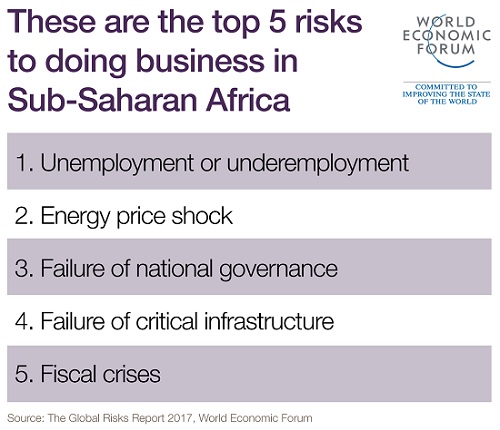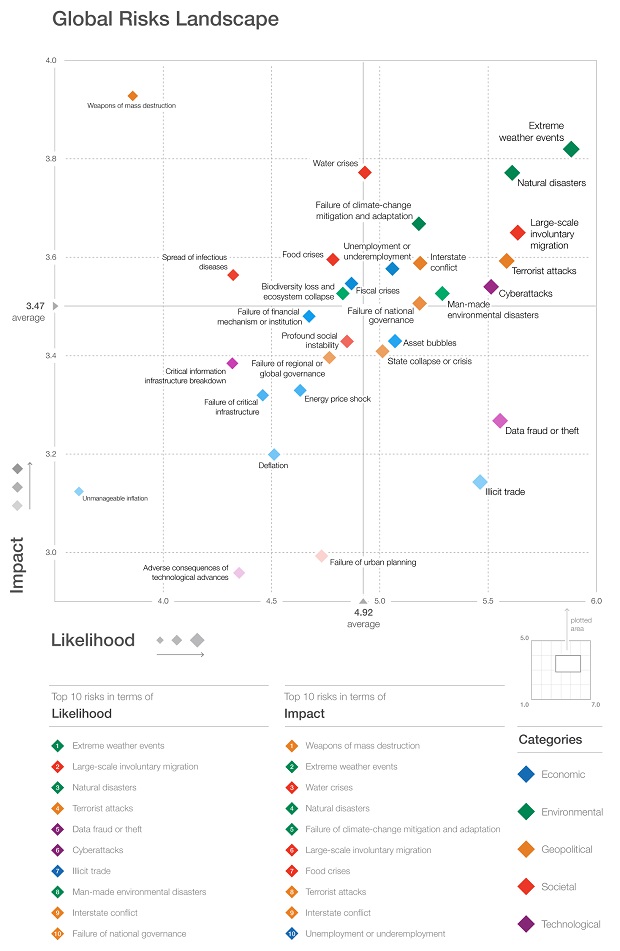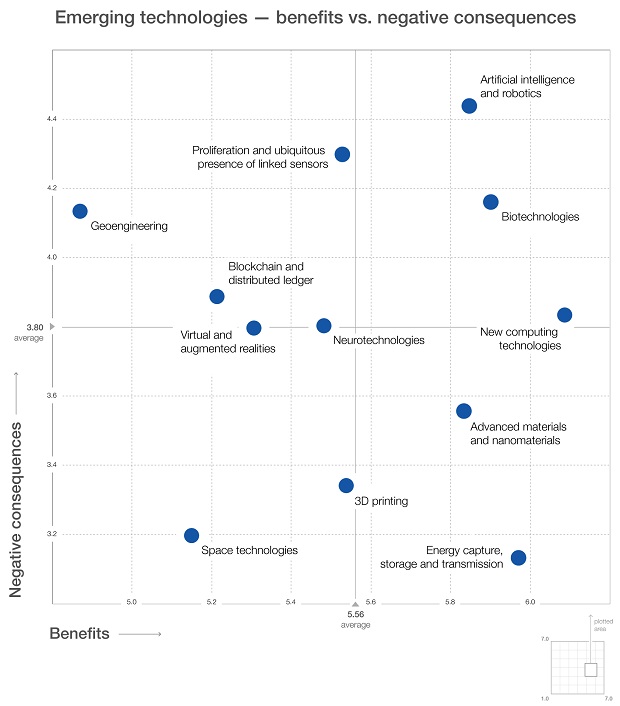News
Under-employed, under-inclusive and under threat: the World in 2017

Trends such as rising income inequality and societal polarization triggered political change in 2016 and could exacerbate global risks in 2017 if urgent action is not taken, according to the Global Risks Report 2017
Economic inequality, societal polarization and intensifying environmental dangers are the top three trends that will shape global developments over the next 10 years, the World Economic Forum’s Global Risks Report 2017 found. Collaborative action by world leaders will be urgently needed to avert further hardship and volatility in the coming decade.
In this year’s annual survey, some 750 experts assessed 30 global risks, as well as 13 underlying trends that could amplify them or alter the interconnections between them. Against a backdrop of mounting political disaffection and disruption across the world, three key findings emerged from the survey:
-
Patterns persist. Rising income and wealth disparity and increasing polarization of societies were ranked first and third, respectively, among the underlying trends that will determine global developments in the next ten years. Similarly, the most interconnected pairing of risks in this year’s survey is between high structural unemployment or underemployment and profound social instability.
-
The environment dominates the global risks landscape. Climate change was the number two underlying trend this year. And for the first time, all five environmental risks in the survey were ranked both high-risk and high-likelihood, with extreme weather events emerging as the single most prominent global risk.
-
Society is not keeping pace with technological change. Of the 12 emerging technologies examined in the report, experts found artificial intelligence and robotics to have the greatest potential benefits, but also the greatest potential negative effects and the greatest need for better governance.
While the world can point to significant progress in the area of climate change in 2016, with a number of countries, including the US and China, ratifying the Paris Agreement, political change in Europe and North America puts this progress at risk. It also highlights the difficulty that leaders will face to agree on a course of action at the international level to tackle the most pressing economic and societal risks.
“Urgent action is needed among leaders to identify ways to overcome political or ideological differences and work together to solve critical challenges. The momentum of 2016 towards addressing climate change shows this is possible, and offers hope that collective action at the international level aimed at resetting other risks could also be achieved,” said Margareta Drzeniek-Hanouz, Head of Global Competitiveness and Risks, World Economic Forum.
How to address the world’s most pressing risks will be the subject of discussions at the World Economic Forum Annual Meeting 2017, which convenes 17-20 January under the theme Responsive and Responsible Leadership.
Although 2016 will be remembered for dramatic political results that broke with consensus expectations, warning signs that a persistent cluster of societal and economic risks could spill over into real-world disruption have been reported in the Global Risks Report regularly during the past decade.
-
In 2006, Global Risks warned that the elimination of privacy reduces social cohesion – at the time, this was classified as a worst-case scenario, with a likelihood of below 1%.
-
In 2013, long before “post-truth” became the 2016 word of the year, Global Risks highlighted the rapid spread of misinformation, observing that trust was being eroded and that better incentives were needed to protect quality-control systems.
The complex transitions that the world is currently going through, from preparing for a low-carbon future and unprecedented technological change to adjusting to new global economic and geopolitical realities, places even greater emphasis on leaders to practice long-term thinking, investment and international cooperation.
“We live in disruptive times where technological progress also creates challenges. Without proper governance and re-skilling of workers, technology will eliminate jobs faster than it creates them. Governments can no longer provide historical levels of social protection and an anti-establishment narrative has gained traction, with new political leaders blaming globalisation for society’s challenges, creating a vicious cycle in which lower economic growth will only amplify inequality. Cooperation is essential to avoid the further deterioration of government finances and the exacerbation of social unrest,” said Cecilia Reyes, Chief Risk Officer of Zurich Insurance Group.
The propensity of the Fourth Industrial Revolution to exacerbate global risks also came under scrutiny in the Report’s Global Risks Perception Survey. Basing their analysis on 12 distinct emerging technologies, experts clearly identified artificial intelligence (AI) and robotics as having both the highest potential for negative consequences and also the greatest need for better governance. Notwithstanding its potential to drive economic growth and solve complex challenges, experts also named it as the top driver of economic, geopolitical and technological risks among the 12 technologies.
John Drzik, President of Global Risk & Specialties, Marsh said: “Artificial intelligence will enable us to address some of the great issues of our age, such as climate change and population growth, much more effectively. With investment into AI now ten times higher than it was five years ago, rapid advances are already being made. However, increased reliance on AI will dramatically exacerbate existing risks, such as cyber, making the development of mitigation measures just as crucial.”
For the third year, the Global Risks Report also provides country-level data on how businesses perceive global risks in their countries.
The Global Risks Report 2017 has been developed with the support of Strategic Partners Marsh & McLennan Companies and Zurich Insurance Group. The report also benefited from the collaboration of its academic advisers: the Oxford Martin School (University of Oxford), the National University of Singapore, the Wharton Risk Management and Decision Processes Center (University of Pennsylvania), and the Advisory Board of the Global Risks Report 2017.

Four key areas for global risks in 2017
The 2017 Global Risks Report comes at a critical moment for the world as we know it. Unprecedented forces are reshaping society, economics, politics and our planet itself in ways some might not have predicted when the first risks report was launched a decade ago.
These tumultuous times can present us with ground-breaking opportunities for changing how we see the world, and how we operate within it. Such change, however, brings with it significant globally interconnected risks, risks which must be factored into modern life.
1. Environmental
The most pressing of these risks relates to our environment. Even though the risk will play out over the long term, actions have to be immediate and long-lasting to have any hope of reversing the trajectory of climate change.
The environment dominates the 2017 global risk landscape in terms of impact and likelihood, with extreme weather events, large natural disasters as well as failure of mitigation and adaptation to climate change as the most prominent global risks. Climate change ranks as one of the top three trends to shape global developments over the next 10 years, and remains one of the truly existential risks to our world. Unlike the threat of nuclear weapons or pandemic disease, however, climate change ranks among the highest in terms of likelihood as well as impact.

Here, cooperation is fundamental to any response to the challenges faced from climate change, from managing “global commons” such as oceans and our atmosphere to enacting international accords like The Paris Agreement and statements that emerged from COP 22. Further progress was made during 2016 in addressing climate and other environmental risks. The pace of change, however, is not fast enough.
2. Socio-economic
Beyond the state of the planet we inhabit, socio-economic considerations have also been high on the collective agenda over the past 12 months, and will continue in importance throughout 2017. These include rising income inequality and the polarization of our society along ethnic, religious and cultural lines. This coming-together of circumstance contributed to profound political change in 2016, and has the potential to exacerbate global risks in 2017.
Beyond geopolitics, social protection systems have suffered from a “perfect storm” of threats since the 2008 financial crisis – and we expect this trend to continue through 2017. Underfunded state social systems, the rise in “non-traditional” employment models from gig economies to zero-hour contracts, prolonged periods of low interest rates that increases the burden of saving for retirement, and demographic pressures like ageing populations and mass migration all place great strain on social protection systems. This means a larger share of the cost and risks for the individual, which can inhibit business growth and harm economies.
We need social protection options that are flexible enough to adapt to new realities in 2017 and beyond. The best social protection solutions will be highly interconnected. Collaboration among state, business and the individual will be crucial. Fail to act and we risk threatening government finances and increasing social unrest.
3. Technological
Technology, in particular, may be where we can turn for innovative solutions to today’s risks and challenges. It may also produce additional risks which must be assessed and factored in to thinking at business, government, and international levels. New and sometimes revolutionary structures such as Artificial Intelligence systems represent such opportunities for streamlining our everyday lives, but also bring with them many potential dangers. These include mismanagement, design vulnerabilities, accidents, unforeseen occurrences and malicious use that post risks to security and safety of individuals.

Furthermore, disruption to labour markets will intensify as jobs seen traditionally as falling under the “skilled labour” category are replaced by machines. The subsequent unemployment or underemployment exacerbates social instability.
Cyber-attacks, software glitches – and even heavy cloud and solar storms – can all have damaging impacts on our new infrastructure, which in 2017 can cover fields as diverse as transport, energy, communications, and water.
4. Cooperative
Finally, we must consider how best to respond to these challenges. Across all five sectors that the Global Risks Report covers this year, we must work together and stand as one as we face up to the global risks of the coming year. Individual responses on topics like climate change, globalization and regulation of the “4th Industrial Revolution” can only achieve so much. In an increasingly interconnected world, it’s clear that collaboration between different countries, sectors and societies will be more important for managing risk than ever before. For companies, responding to global risks will require a truly holistic risk management approach taking inter-dependencies between risks into account.
This article was written by Cecilia Reyes, Group Chief Risk Officer, Zurich Insurance Group. The views expressed here are those of the author alone and not the World Economic Forum.




